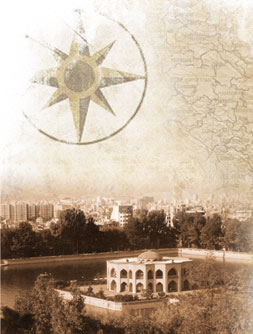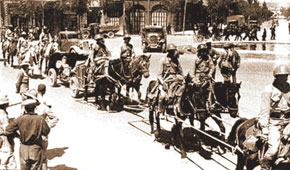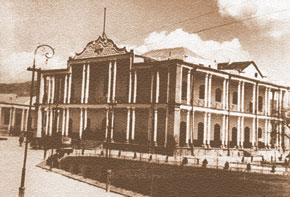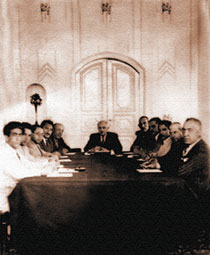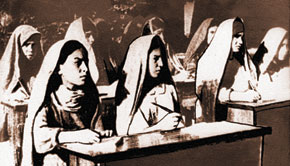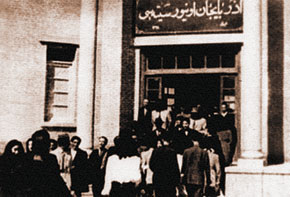Pages 68-73
by Akram Rahimli (Bije)
The 21 Azer* movement (the 12 December 1945 revolution) is seen as the culmination of the national-democratic movement in Southern Azerbaijan (Iran). The Mashruta revolution of the early 20th century (1905-1911) and the subsequent Khiyabani movement (1917-1920) were in essence just stages in the revival and revolutionary and processes leading to the 21 Azer. In other words, the 21 Azer was their logical continuation. It was no coincidence that most of the issues on the agenda of Azerbaijan’s national government in 1945-1946 overlapped those in the programmes and goals of previous movements. Quite a few activists from these movements subsequently formed the nucleus of the 21 Azer.
Cometh the hour, cometh the man
The entry of allied troops to Iran in August 1941 led to the collapse of Shah Rza’s regime and enabled the Turks of the South to stand up and defend their ethnic rights. Even though the Azerbaijan Society, the Freedom Front, the Democracy Hearth, the Province Committee of the Iranian People’s Party (Tudeh) and a number of other parties, societies and organizations emerged in Southern Azerbaijan, none of them lived up to people’s wishes and expectations. A political organization was needed that would serve Azerbaijan’s national interests with a love of freedom and the motherland, that was capable of leading the people to a common goal, proceeding from national-democratic values and supported by the patriotic forces in society. Several intellectuals from Tabriz sent written and oral requests to the editor of Tehran’s Ajir newspaper, the revolutionary Sayyed Jafar Pishevari (1892-1947), asking him to go to Tabriz and establish such a political party. Pishevari subsequently wrote in his memoirs, “I could not refuse the call of the people. Therefore, I had to come to Azerbaijan.”
Pishevari’s arrival in Tabriz and the work he did there yielded fruit. After certain deliberations, 77 Azerbaijanis (mostly participants in the Sattarkhan or Khiyabani movements or their children) adopted the “12 Shahrivar” (3 September) declaration and made it public. The declaration actually represented an appeal to the people. It analyzed the unbearable socio-political, economic and cultural situation in Southern Azerbaijan, identified collective struggle as the only way forward and stated the need for a political organization capable of doing that. The issues raised in the declaration (12 points) effectively formed the popular movement’s agenda. The newspaper Azerbaijan, which began publication two days after the adoption of the declaration, played an exceptional role in communicating this agenda to the people, reviving national morale and convincing people of the need for an independent, national political organization to lead the way. The Local Committee of the Iranian People’s Party, which was operating in Azerbaijan at that time, announced that it, together with its 40,000 members, was joining the newly-established Azerbaijan Democratic Party (ADP).
First an independent party....
The first plenary session of the ADP was held on 13 September 1945 and set up an 11-member Committee of Founders. The renowned democrat and journalist Pishevari, who had been sentenced to 10 years in prison by Shah Rza, was elected chairman of the Committee. The Committee convened the first party congress on 2 October 1945 (10 Mehr 1325) and announced the nomination of local representatives to the congress. That first congress was attended by 277 delegates. A total of six sessions were held over the course of two days. The congress approved the establishment of the ADP, adopted a programme and charter, and endorsed the make-up of the party’s governing body (Central Committee). Pishevari was elected chairman of the Central Committee. The Committee carried out a number of important activities relating to the international and domestic situation and, in order to discuss the overall situation and find solutions to existing problems, it decided to hold the second plenary session of the Party on 18 November.
This plenary session played a special role in the history of the Party and the 21 Azer movement. It revealed facts showing the cruel nature of the regime, violence by the gendarmerie and police, and stated that the people were left with no option but to resist such arbitrariness. Instead of taking firm steps to rectify the situation in Southern Azerbaijan, Tehran turned a blind eye to the numerous appeals and complaints from the region. Official documents of the Party indicate that the “numerous complaints sent to the shah, prime minister and the Majlis about the dire economic situation, unemployment, high prices, violence and arbitrary behaviour of government officials, unfounded arrests and persecution, remained unanswered”. Prime Minister Murtuzaqulu Bayar said once, “I have addressed the nation over the radio, so the people need not send written complaints”. The next prime minister, Ibrahim Hakimi, went even further, saying, “even if we receive a thousand messages by telegraph, I won’t dignify these empty words with an answer”.
Pishevari published his article Let them leave us alone, written in the run-up to the 21st Azer, in the Azerbaijan newspaper. He wrote, “Azerbaijan doesn’t want anything from Tehran: let them just leave us alone. Let them allow Azerbaijan to run itself by itself. Tehran doesn’t allow us any breathing space, it always wants to be in charge when we try to do something ourselves. Every day it sends us its thieves disguised as governors or commanders and carrying huge suitcases. They are not ashamed of shaving our heads with a new, sharp razor over and over again.” It was under these unbearable circumstances that the 21 Azer movement emerged in Southern Azerbaijan.
...then an independent government
On the eve of the 21st Azer, on 20 November (29 Aban) 1945, the National People’s Congress (NPC) was convened in Tabriz. Delegates from every region of Southern Azerbaijan (a total of 724 people) were invited to attend. The congress provided a comprehensive analysis of the political and economic situation in Southern Azerbaijan. After listening to remarks and suggestions from delegates, the congress adopted a resolution containing 14 clauses. The decision was made to give the Southern Azerbaijan Assembly the status of Milli Majlis (national assembly). The congress also adopted an address to Iran’s shah, Majlis and prime minister, as well as to other countries. The address described the tough social, political, economic and cultural situation in Southern Azerbaijan, saying that a people with a rich cultural and historical background were on the verge of extinction and were being denied their language and national identity. The address said further, “… people’s patience is about to run out, they are no longer able to withstand Tehran’s tyranny and humiliation and will be obliged to meet force with force.”
The Congress also elected a 39-member National Council (NC), appointing Pishevari chairman and Haji Mirzaali deputy chairman. The Council was tasked with convening the Milli Majlis and attending to important current affairs. Between 27 November and 1 December 1945, a total of 100 delegates from 32 constituencies were elected to the Milli Majlis. As a result, Azerbaijan’s Milli Majlis was opened in Tabriz on 21 December 1945. The Majlis began its work on the basis of the Internal Charter prepared by the NC and approved at its first session. The Charter stated that Azerbaijani autonomy was being established within the framework of the territorial integrity of Iran, while the local assembly was being replaced by the Azerbaijan National Government. The National Government did not have ministries of foreign affairs, defence or foreign trade, which meant that it would function as an autonomous entity within Iran. In fact, there are many examples of such autonomies around the world.
The Milli Majlis elected a nine-member presidium to pass and execute laws and decisions, with Haji Mirzaali Shabustari in the chair. It also passed the historic decision to establish the National Government and unanimously elected Mishevari as its chairman. By then, many regions of Southern Azerbaijan, in addition to Tabriz and Urmia, had broken away from Tehran’s tyranny. Tabriz was freed of enemy forces on 13 and Urmia on 19 December.
The Milli Majlis led by Pishevari approved 11 members of the Azerbaijan National Government. This government existed for just one year, but the work carried out in the socio-economic, scientific, educational and cultural fields over such a short period of time, according to American sociologist John Foran, “outweighed what Shah Rza had done in 20 years”.
Out of tyranny, democracy
The reforms conducted by the National Government in the areas of democracy, economy, culture etc. were so extensive that it would be impossible to describe them in a few sentences. The adoption of a law on democratic elections, the provision of freedom to political parties and associations, the regulation of ethnic relations, the emancipation of women etc. are among the most significant measures taken by the national government in the sphere of democratic law. The revitalization and development of national industry, the elimination of unemployment, the protection of domestic investment and numerous other improvements earned the short-lived government a reputation for being pro-development. As an agricultural region, Southern Azerbaijan always faced problems with land and fair regulation of villager-landowner relations. This issue remains on the agenda to this day. The Azerbaijan National Government resolved this problem in a democratic and fair manner. The lands of those who had fled the country, as well as the shah’s estates, were distributed freely among villagers who had little or no land. Those who had too much land and irrigation water at their disposal were made to share it with those in need. Tax disputes between landowners and villagers were resolved in favour of the latter, as thousands of destitute villagers acquired land, gardens and pastures.
Even more work was done on education and culture. The decision of the Milli Majlis to make the Azerbaijani language the official state language, the establishment of a national philharmonic society, a radio station, national theatres and museums, a national orchestra, associations of writers, artists and art critics, the first school of higher education – a State University, the construction of new schools and orphanages, the establishment of a national library etc. effectively produced a cultural renaissance in Azerbaijan.
The reasons behind the emergence of the 21 Azer movement should be sought in the tyranny of the Pahlavi dynasty against Azerbaijani Turks, the policy of discrimination and the unbearable socio-economic and political situation in Azerbaijan. Prominent Iranian statesman Mohammad Mosaddegh said in a speech at the Iranian Council Assembly on 14 December 1945, “the situation in Azerbaijan was the result of the government failing to listen to people’s objections and resorting to force instead of responding to people’s concerns”. A similar opinion was also voiced by Iran’s Prime Minister Ahmad Qavam.
From the people
The 21 Azer was a popular national movement that emerged solely on a wave of people’s wishes and power. It would be at least a distortion of history to look outside Iran or to describe it as a movement brought to life by external forces (the Soviets). It would be an insult to the memories of the 25,000 freedom-fighters who fell victim for the cause of the 21 Azer. It is also wrong to provide an objective assessment to the movement without taking into consideration its relationship with the other side of the Aras river, the Soviet Union, as well as certain other domestic and external factors.
It is impossible to deny the moral and, in part, military assistance by the Soviets to the Southern Azerbaijan movement in 1945-1946. However, it would also be naive to deny that the main driving force behind the 21 Azer, a movement that represented all the national liberation forces of Southern Azerbaijan, was the people. Only those unfamiliar with the situation, or indeed hostile towards the movement, attributed its successes to the Soviets. It is particularly important to note that all Soviet assistance to the movement and its leaders was provided at the expense of northern Azerbaijan (the Azerbaijan Soviet Socialist Republic – A. R.). The north was no less interested in achieving freedom and happiness for the south than the south itself. However, the behind-the-scenes treachery masterminded by the Stalin-Mikoyan alliance and the support from the US and British for Tehran’s suppression of the popular movement in Southern Azerbaijan led to its defeat.
Since the 21 Azer had deep roots, it is still remembered in the South. The more time separates us from it, the more information is revealed, especially by the youth. Even those not very friendly towards the movement acknowledge that the seeds it sowed in Southern Azerbaijan are still latent in the soil. As Pishevari wrote in one of his articles, “Tehran can’t always trample on our people’s human rights. Sooner or later Azerbaijanis will break free and develop independently.”
About the author: Akram Rahimli (Bije), Ph.D. in History, is a senior researcher at the Ziya Bunyadov Institute of Oriental Studies of the Azerbaijan National Academy of Sciences. He is the author of six books and numerous publications on the history, economics and literature of Southern Azerbaijan.
*(ed. The 21 Azer movement takes its name from the date in the Iranian calendar when the Azerbaijan National Government was established)
by Akram Rahimli (Bije)
The 21 Azer* movement (the 12 December 1945 revolution) is seen as the culmination of the national-democratic movement in Southern Azerbaijan (Iran). The Mashruta revolution of the early 20th century (1905-1911) and the subsequent Khiyabani movement (1917-1920) were in essence just stages in the revival and revolutionary and processes leading to the 21 Azer. In other words, the 21 Azer was their logical continuation. It was no coincidence that most of the issues on the agenda of Azerbaijan’s national government in 1945-1946 overlapped those in the programmes and goals of previous movements. Quite a few activists from these movements subsequently formed the nucleus of the 21 Azer.
Cometh the hour, cometh the man
The entry of allied troops to Iran in August 1941 led to the collapse of Shah Rza’s regime and enabled the Turks of the South to stand up and defend their ethnic rights. Even though the Azerbaijan Society, the Freedom Front, the Democracy Hearth, the Province Committee of the Iranian People’s Party (Tudeh) and a number of other parties, societies and organizations emerged in Southern Azerbaijan, none of them lived up to people’s wishes and expectations. A political organization was needed that would serve Azerbaijan’s national interests with a love of freedom and the motherland, that was capable of leading the people to a common goal, proceeding from national-democratic values and supported by the patriotic forces in society. Several intellectuals from Tabriz sent written and oral requests to the editor of Tehran’s Ajir newspaper, the revolutionary Sayyed Jafar Pishevari (1892-1947), asking him to go to Tabriz and establish such a political party. Pishevari subsequently wrote in his memoirs, “I could not refuse the call of the people. Therefore, I had to come to Azerbaijan.”
Pishevari’s arrival in Tabriz and the work he did there yielded fruit. After certain deliberations, 77 Azerbaijanis (mostly participants in the Sattarkhan or Khiyabani movements or their children) adopted the “12 Shahrivar” (3 September) declaration and made it public. The declaration actually represented an appeal to the people. It analyzed the unbearable socio-political, economic and cultural situation in Southern Azerbaijan, identified collective struggle as the only way forward and stated the need for a political organization capable of doing that. The issues raised in the declaration (12 points) effectively formed the popular movement’s agenda. The newspaper Azerbaijan, which began publication two days after the adoption of the declaration, played an exceptional role in communicating this agenda to the people, reviving national morale and convincing people of the need for an independent, national political organization to lead the way. The Local Committee of the Iranian People’s Party, which was operating in Azerbaijan at that time, announced that it, together with its 40,000 members, was joining the newly-established Azerbaijan Democratic Party (ADP).
First an independent party....
The first plenary session of the ADP was held on 13 September 1945 and set up an 11-member Committee of Founders. The renowned democrat and journalist Pishevari, who had been sentenced to 10 years in prison by Shah Rza, was elected chairman of the Committee. The Committee convened the first party congress on 2 October 1945 (10 Mehr 1325) and announced the nomination of local representatives to the congress. That first congress was attended by 277 delegates. A total of six sessions were held over the course of two days. The congress approved the establishment of the ADP, adopted a programme and charter, and endorsed the make-up of the party’s governing body (Central Committee). Pishevari was elected chairman of the Central Committee. The Committee carried out a number of important activities relating to the international and domestic situation and, in order to discuss the overall situation and find solutions to existing problems, it decided to hold the second plenary session of the Party on 18 November.
This plenary session played a special role in the history of the Party and the 21 Azer movement. It revealed facts showing the cruel nature of the regime, violence by the gendarmerie and police, and stated that the people were left with no option but to resist such arbitrariness. Instead of taking firm steps to rectify the situation in Southern Azerbaijan, Tehran turned a blind eye to the numerous appeals and complaints from the region. Official documents of the Party indicate that the “numerous complaints sent to the shah, prime minister and the Majlis about the dire economic situation, unemployment, high prices, violence and arbitrary behaviour of government officials, unfounded arrests and persecution, remained unanswered”. Prime Minister Murtuzaqulu Bayar said once, “I have addressed the nation over the radio, so the people need not send written complaints”. The next prime minister, Ibrahim Hakimi, went even further, saying, “even if we receive a thousand messages by telegraph, I won’t dignify these empty words with an answer”.
Pishevari published his article Let them leave us alone, written in the run-up to the 21st Azer, in the Azerbaijan newspaper. He wrote, “Azerbaijan doesn’t want anything from Tehran: let them just leave us alone. Let them allow Azerbaijan to run itself by itself. Tehran doesn’t allow us any breathing space, it always wants to be in charge when we try to do something ourselves. Every day it sends us its thieves disguised as governors or commanders and carrying huge suitcases. They are not ashamed of shaving our heads with a new, sharp razor over and over again.” It was under these unbearable circumstances that the 21 Azer movement emerged in Southern Azerbaijan.
...then an independent government
On the eve of the 21st Azer, on 20 November (29 Aban) 1945, the National People’s Congress (NPC) was convened in Tabriz. Delegates from every region of Southern Azerbaijan (a total of 724 people) were invited to attend. The congress provided a comprehensive analysis of the political and economic situation in Southern Azerbaijan. After listening to remarks and suggestions from delegates, the congress adopted a resolution containing 14 clauses. The decision was made to give the Southern Azerbaijan Assembly the status of Milli Majlis (national assembly). The congress also adopted an address to Iran’s shah, Majlis and prime minister, as well as to other countries. The address described the tough social, political, economic and cultural situation in Southern Azerbaijan, saying that a people with a rich cultural and historical background were on the verge of extinction and were being denied their language and national identity. The address said further, “… people’s patience is about to run out, they are no longer able to withstand Tehran’s tyranny and humiliation and will be obliged to meet force with force.”
The Congress also elected a 39-member National Council (NC), appointing Pishevari chairman and Haji Mirzaali deputy chairman. The Council was tasked with convening the Milli Majlis and attending to important current affairs. Between 27 November and 1 December 1945, a total of 100 delegates from 32 constituencies were elected to the Milli Majlis. As a result, Azerbaijan’s Milli Majlis was opened in Tabriz on 21 December 1945. The Majlis began its work on the basis of the Internal Charter prepared by the NC and approved at its first session. The Charter stated that Azerbaijani autonomy was being established within the framework of the territorial integrity of Iran, while the local assembly was being replaced by the Azerbaijan National Government. The National Government did not have ministries of foreign affairs, defence or foreign trade, which meant that it would function as an autonomous entity within Iran. In fact, there are many examples of such autonomies around the world.
The Milli Majlis elected a nine-member presidium to pass and execute laws and decisions, with Haji Mirzaali Shabustari in the chair. It also passed the historic decision to establish the National Government and unanimously elected Mishevari as its chairman. By then, many regions of Southern Azerbaijan, in addition to Tabriz and Urmia, had broken away from Tehran’s tyranny. Tabriz was freed of enemy forces on 13 and Urmia on 19 December.
The Milli Majlis led by Pishevari approved 11 members of the Azerbaijan National Government. This government existed for just one year, but the work carried out in the socio-economic, scientific, educational and cultural fields over such a short period of time, according to American sociologist John Foran, “outweighed what Shah Rza had done in 20 years”.
Out of tyranny, democracy
The reforms conducted by the National Government in the areas of democracy, economy, culture etc. were so extensive that it would be impossible to describe them in a few sentences. The adoption of a law on democratic elections, the provision of freedom to political parties and associations, the regulation of ethnic relations, the emancipation of women etc. are among the most significant measures taken by the national government in the sphere of democratic law. The revitalization and development of national industry, the elimination of unemployment, the protection of domestic investment and numerous other improvements earned the short-lived government a reputation for being pro-development. As an agricultural region, Southern Azerbaijan always faced problems with land and fair regulation of villager-landowner relations. This issue remains on the agenda to this day. The Azerbaijan National Government resolved this problem in a democratic and fair manner. The lands of those who had fled the country, as well as the shah’s estates, were distributed freely among villagers who had little or no land. Those who had too much land and irrigation water at their disposal were made to share it with those in need. Tax disputes between landowners and villagers were resolved in favour of the latter, as thousands of destitute villagers acquired land, gardens and pastures.
Even more work was done on education and culture. The decision of the Milli Majlis to make the Azerbaijani language the official state language, the establishment of a national philharmonic society, a radio station, national theatres and museums, a national orchestra, associations of writers, artists and art critics, the first school of higher education – a State University, the construction of new schools and orphanages, the establishment of a national library etc. effectively produced a cultural renaissance in Azerbaijan.
The reasons behind the emergence of the 21 Azer movement should be sought in the tyranny of the Pahlavi dynasty against Azerbaijani Turks, the policy of discrimination and the unbearable socio-economic and political situation in Azerbaijan. Prominent Iranian statesman Mohammad Mosaddegh said in a speech at the Iranian Council Assembly on 14 December 1945, “the situation in Azerbaijan was the result of the government failing to listen to people’s objections and resorting to force instead of responding to people’s concerns”. A similar opinion was also voiced by Iran’s Prime Minister Ahmad Qavam.
From the people
The 21 Azer was a popular national movement that emerged solely on a wave of people’s wishes and power. It would be at least a distortion of history to look outside Iran or to describe it as a movement brought to life by external forces (the Soviets). It would be an insult to the memories of the 25,000 freedom-fighters who fell victim for the cause of the 21 Azer. It is also wrong to provide an objective assessment to the movement without taking into consideration its relationship with the other side of the Aras river, the Soviet Union, as well as certain other domestic and external factors.
It is impossible to deny the moral and, in part, military assistance by the Soviets to the Southern Azerbaijan movement in 1945-1946. However, it would also be naive to deny that the main driving force behind the 21 Azer, a movement that represented all the national liberation forces of Southern Azerbaijan, was the people. Only those unfamiliar with the situation, or indeed hostile towards the movement, attributed its successes to the Soviets. It is particularly important to note that all Soviet assistance to the movement and its leaders was provided at the expense of northern Azerbaijan (the Azerbaijan Soviet Socialist Republic – A. R.). The north was no less interested in achieving freedom and happiness for the south than the south itself. However, the behind-the-scenes treachery masterminded by the Stalin-Mikoyan alliance and the support from the US and British for Tehran’s suppression of the popular movement in Southern Azerbaijan led to its defeat.
Since the 21 Azer had deep roots, it is still remembered in the South. The more time separates us from it, the more information is revealed, especially by the youth. Even those not very friendly towards the movement acknowledge that the seeds it sowed in Southern Azerbaijan are still latent in the soil. As Pishevari wrote in one of his articles, “Tehran can’t always trample on our people’s human rights. Sooner or later Azerbaijanis will break free and develop independently.”
About the author: Akram Rahimli (Bije), Ph.D. in History, is a senior researcher at the Ziya Bunyadov Institute of Oriental Studies of the Azerbaijan National Academy of Sciences. He is the author of six books and numerous publications on the history, economics and literature of Southern Azerbaijan.
*(ed. The 21 Azer movement takes its name from the date in the Iranian calendar when the Azerbaijan National Government was established)
